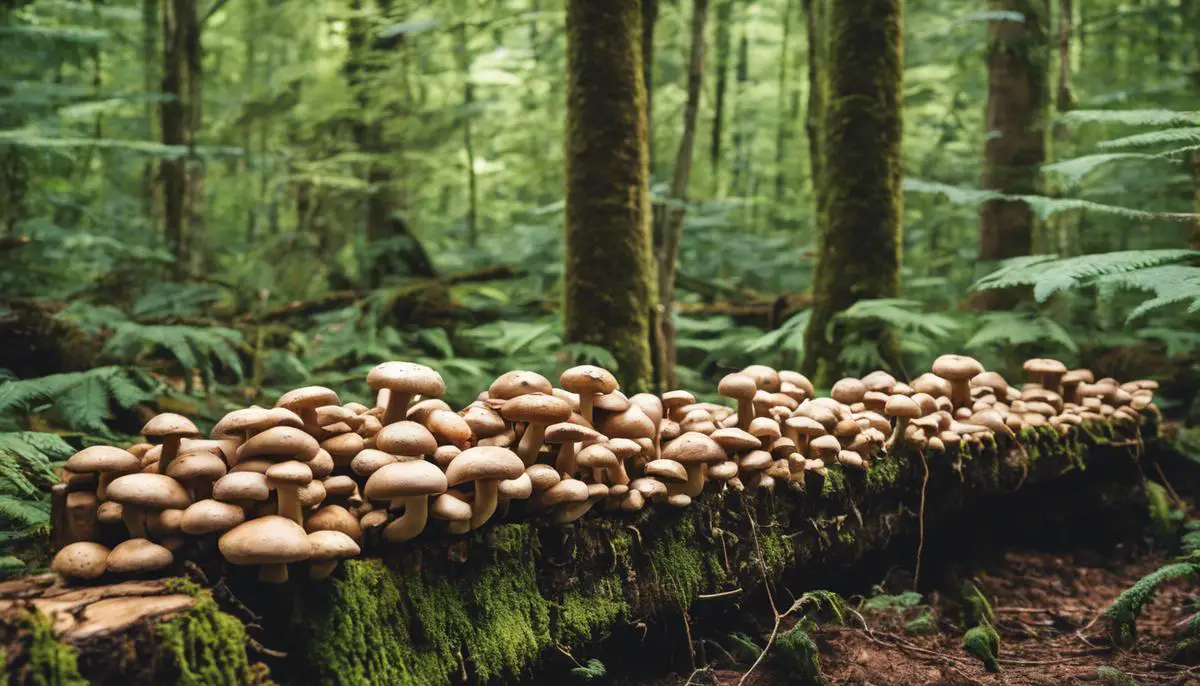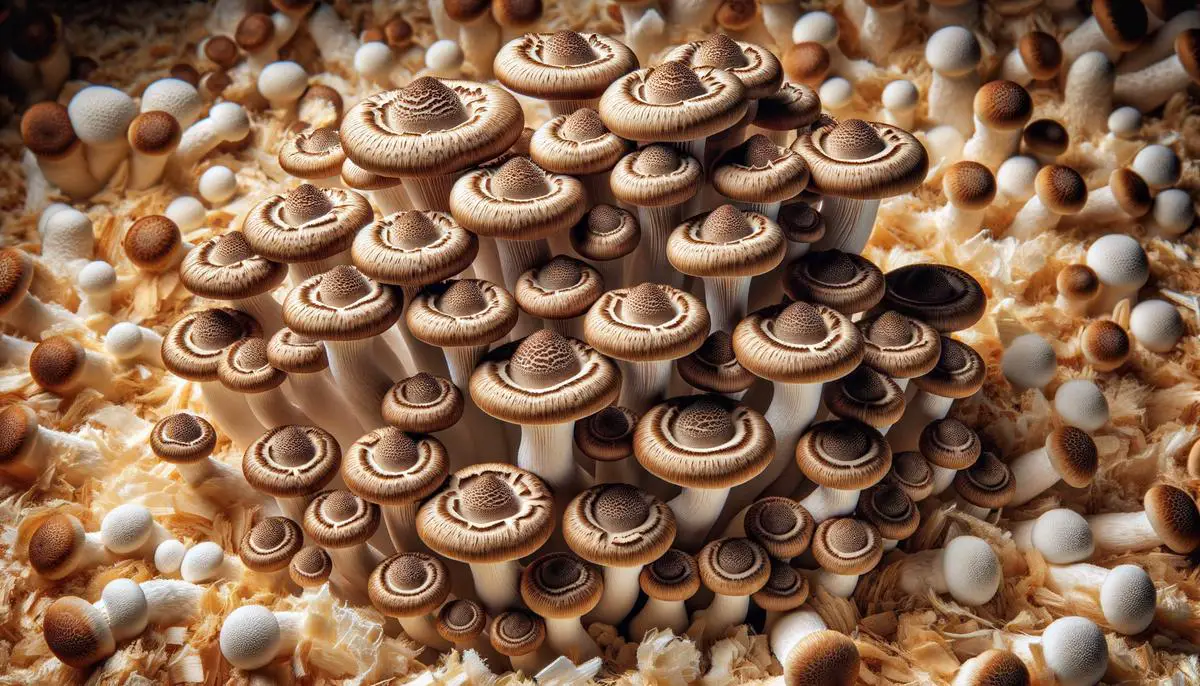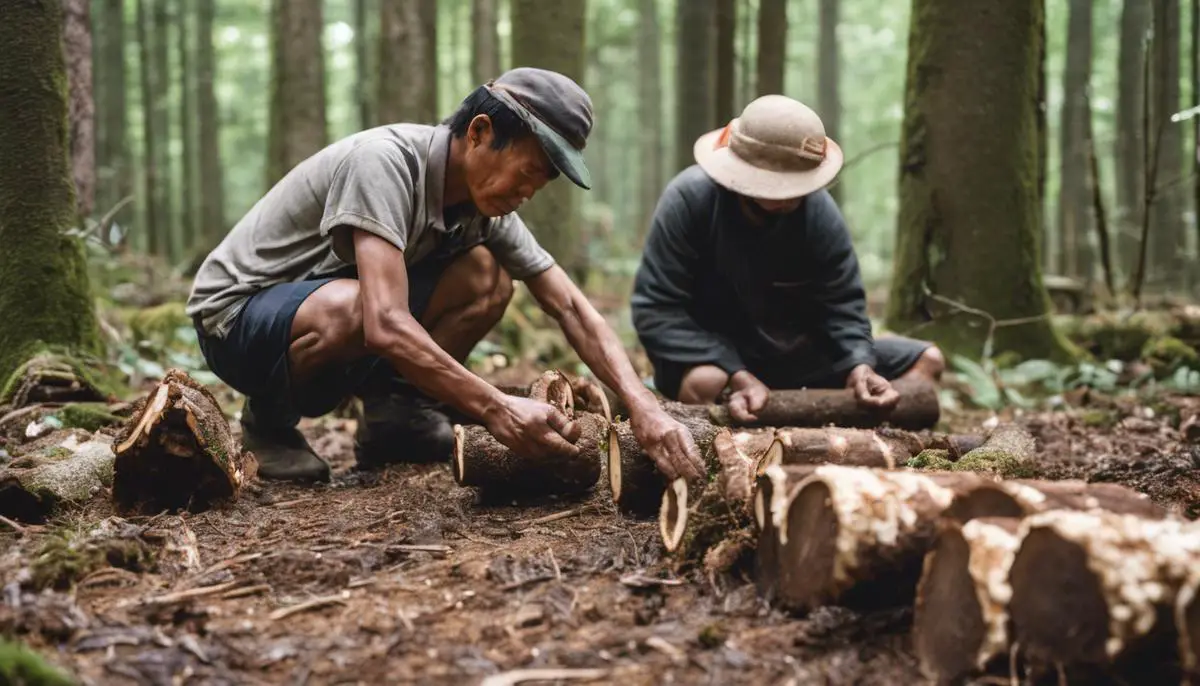
Shiitake Cultivation History
Around the year 1209, during the Song Dynasty in China, people first recorded the method of shiitake cultivation on wood logs. This innovative technique transformed the humble mushroom into a cultivated food source that would spread across continents.
The term "shiitake" emerges from the Japanese words "shii," referring to the tree on which these mushrooms naturally grew, and "take," meaning mushroom. Initially, shiitake mushrooms were cultivated on shii tree logs, mirroring the fungi's natural growth preferences. By emulating natural conditions, cultivators were able to harness and increase shiitake production for dietary and medicinal purposes.
In the 1930s, shiitake cultivation advanced significantly in Japan. Cultivators began growing shiitakes on various hardwood logs, closely replicating their natural environment. This development marked a significant chapter in the history of shiitake cultivation, setting the stage for global expansion.
Today, shiitake mushrooms are not confined to traditional log cultivation. With advancements in technology and a deeper understanding of mycology, sawdust and other artificial substrates have become common bases for cultivation, allowing for more controlled environments and faster production cycles. These innovations have played a pivotal role in making shiitake mushrooms the second most cultivated species worldwide.
The transition from log-based to sawdust cultivation was a result of years of experimentation and ingenuity, striving to find a cost-effective and efficient way to raise shiitakes. This shift also enabled large-scale production, turning shiitake mushrooms into a culinary and economic powerhouse recognized globally.
Despite these modern advances, some farmers still adhere to the ancient method of growing shiitakes on logs to preserve the mushroom's unique flavor profile and nutritional value. This dedication to traditional practices underscores the cultural importance of shiitakes, bridging past and present cultivation methods.
Shiitake mushrooms have also moved beyond their Asian origins and are now enjoyed and cultivated worldwide. Their journey from ancient forests to international kitchens underscores their versatility and enduring appeal. As demand continues to grow, both traditional and contemporary cultivation techniques ensure shiitakes remain a notable ingredient in global cuisines.
These mushrooms are celebrated not only for their taste but also for their nutritional and health benefits. From their early medicinal use in China to modern studies exploring their immune-boosting properties, shiitakes have long been considered a superfood.
In every hewn log or substrate bag, there's a piece of history and a testament to human ingenuity in harnessing nature's gifts. The evolution of shiitake cultivation mirrors broader agricultural advancements, showcasing our ongoing relationship with the fungi kingdom.

Nutritional and Medicinal Benefits
Nutritional and Medicinal Benefits
Shiitake mushrooms are renowned for their impressive nutritional profile and potential health benefits. They are rich in B vitamins, essential minerals, and all eight essential amino acids, making them a nutritional powerhouse.
Shiitakes are an excellent source of B vitamins, including thiamin, riboflavin, niacin, pantothenic acid, pyridoxine, and folate. These vitamins play critical roles in energy production, brain health, and maintaining optimal physiological functions. Incorporating shiitakes into one's diet can help bridge nutritional gaps.
In terms of mineral content, shiitake mushrooms are a rich source of copper, which supports iron absorption and red blood cell formation. They also contain selenium, known for its antioxidant properties and role in DNA synthesis, as well as zinc, which contributes to immune function.
Shiitakes are also a source of essential amino acids critical for protein synthesis. Unlike most plant-based proteins, they contain all essential amino acids in a favorable composition, making them a complete protein source. This is particularly beneficial for vegetarians, vegans, and those reducing animal protein intake.
Beyond their nutritional value, shiitake mushrooms are celebrated for their medicinal benefits. Studies have explored shiitakes' contribution to boosting the immune system, thanks to compounds like lentinan, a polysaccharide with antitumor effects. Regular consumption of these mushrooms may enhance immune defenses.
Shiitakes have also shown promise in managing cholesterol levels. Research highlights components like eritadenine and beta-glucans that may help lower bad cholesterol and maintain healthy blood vessels, potentially supporting heart health and reducing cardiovascular risk.
The potential anticancer properties of shiitake mushrooms form another pillar of their medicinal value. While research is ongoing, findings suggest that compounds within shiitakes could help slow tumor growth or boost the effectiveness of chemotherapy.
Incorporating shiitake mushrooms into one's diet not only enriches the palate but also offers an array of health benefits. Each serving of shiitakes provides a blend of nutrients and bioactive compounds that support vitality and well-being, reflecting the remarkable convergence of nutrition and medicine found within this fungus.
The fusion of nutritional richness and medicinal properties within shiitake mushrooms encapsulates their long-standing history as a food and healing agent. They serve as both culinary delights and promoters of holistic health, highlighting the profound connections between diet and wellness.

Sustainable Farming Practices
Shiitake mushroom cultivation is an excellent example of sustainable farming practices that combine agroecological principles with economic viability for small-scale farmers. This symbiotic relationship between agriculture and forestry, known as agroforestry, can enhance biodiversity and contribute to the rejuvenation of local ecosystems. By integrating shiitake cultivation within these systems, farmers can promote forest regeneration and soil health while drawing from and enriching their natural surroundings.
Forests are complex ecosystems teeming with life and resources. Shiitake cultivation, particularly on hardwood logs, utilizes naturally fallen or sustainably harvested wood without compromising forest health. These logs, prepared and inoculated with shiitake spores, become mini ecosystems themselves. As the shiitakes thrive, they break down cellulose and lignin in the wood, returning nutrients to the soil, enhancing its fertility and structure, and fostering a more resilient forest ecosystem.
Moreover, shiitake cultivation requires no harmful pesticides or chemicals, aligning with the principles of organic farming and ensuring that both the produce and the environment remain uncontaminated. This emphasis on ecological harmony makes shiitake cultivation a model of sustainable agriculture, offering both economic profitability and environmental stewardship.
Shiitake farming also provides a practical solution for small-scale farmers seeking sustainable livelihoods. In regions where conventional farming is challenged by unsuitable soil or adverse climate conditions, shiitake cultivation on logs offers a viable alternative. These mushrooms have an appealing market value and demand, allowing farmers to secure a sustainable income source that resonates with growing trends in health-conscious and gourmet foods.
Success stories can be found from the Ozarks in Missouri to the northeastern United States and beyond, where small-scale farmers have carved a niche for themselves in the shiitake industry1-3. Such initiatives often foster broader community involvement and benefits, supporting local economies and demonstrating the economic vitality of sustainable farming practices.
Furthermore, these localized shiitake ventures exemplify how diversification in farming systems can mitigate risk and contribute to the social fabric of rural communities by providing cooperative selling opportunities, shared resources, and knowledge transfer among growers.
The transformative impact of shiitake cultivation on both local ecosystems and economies demonstrates the powerful synergy between sustainable agriculture and community development. As these practices enhance biodiversity and soil vitality, they also empower farmers to cultivate financial resilience and enable communities to thrive autonomously. Through this harmonious dialogue with nature, rooted in respect and reciprocity, shiitake mushroom cultivation emerges as a testament to sustainable farming's promising future and an emblem of agriculture's age-old wisdom: to give back to the earth as much as we take.

The cultivation of shiitake mushrooms offers valuable lessons for sustainable agriculture and dietary wellness. By honoring traditional methods while embracing innovation, we can preserve the rich flavor and nutritional benefits of shiitakes while contributing to a healthier planet. This balance between tradition and progress underscores the vital role shiitakes play in our lives, bridging cultures and cuisines with every savory bite.
- Bruhn JN, Hall M. Growing shiitake mushrooms in an agroforestry practice. Univ Mo Cent Agrofor. 2008;1-12.
- Mudge K, Petersen KL, Hoover E. Small-scale shiitake mushroom production on hardwood logs. Cornell Univ Coop Ext. 2014;1-8.
- Roberts C, Kozak R, Fischer B. The current state of log-based shiitake mushroom production in the northeastern United States. J Ext. 2018;56(4):4FEA8.


